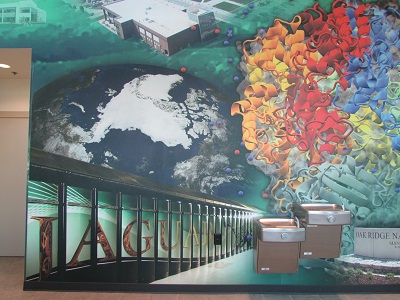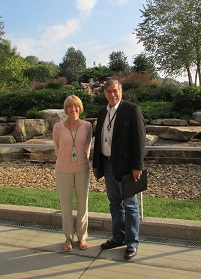International Fusion Research in my Backyard? Yes, Please!
[Suzy is at it again, this time touring nuclear sites all over North America. Make sure to check out her latest adventures at the Nuclear Literacy Project]
Earlier last year I spent about three months traveling throughout Europe learning about research, outreach, and all kinds of other nuclear related issues in many different countries and cultures. When I returned home in April I started the process of sharing my findings with the American nuclear industry, giving talks about my travels at universities and conferences throughout the country.
But recently, something very interesting has happened-nuclear facilities closer to home have started asking me to come visit, give talks, and write about their facilities. In a way, I guess going abroad has helped me realize that there are abundant, fascinating nuclear projects happening in my own backyard.
For instance, when I was in Germany I learned all about the International Thermonuclear Experimental Reactor (ITER) project-since Germany's fission reactors are scheduled to eventually be shuttered, the research community has been strengthening its already existing commitment to ITER. It has the tools, facilities, and people-so it makes sense. The thing is, just two hours from my home is another partner in the ITER project-Oak Ridge National Laboratory-that I had always sort of thought of as a weapons site, so I hadn't actively pursued a tour.
Thankfully, earlier this year I received an invite to see Oak Ridge-and happily accepted. Here's what I learned: Despite its history of involvement, like much of the national laboratory system, Oak Ridge is no longer engaged in weapons work-in fact, it is currently on the cutting edge of computer and energy research.
When I arrived I was amazed to see that the grounds look like a college campus. As I walked into the welcome center I was pleased to find a gorgeous mural in the entryway and a brand new cafeteria where I met Mark Uhran, the U.S. ITER project communications manager.
Mark enthusiastically told me about his previous work on the International Space Station, and pointed out that the ITER project is second only to the space station endeavor in terms of large-scale international systems organizations. And while France houses the reactor itself, six countries are involved with engineering and manufacturing for the project-including 100 full-time employees here in the United States.
 Some of the challenges with a project of this scope and scale include working across time zones, language barriers, and differing engineering cultures-but the potential benefits of a successful international fusion program are limitless. As a professional communicator, Mark was drawn to this project, which he sees as "a new step in engineering for humanity. [ITER] is a planetary organization that minimizes risks and cost to individual countries, while increasing access to both basic and advanced technologies globally."
Some of the challenges with a project of this scope and scale include working across time zones, language barriers, and differing engineering cultures-but the potential benefits of a successful international fusion program are limitless. As a professional communicator, Mark was drawn to this project, which he sees as "a new step in engineering for humanity. [ITER] is a planetary organization that minimizes risks and cost to individual countries, while increasing access to both basic and advanced technologies globally."
After breakfast with Mark, I took off to see the lab with official tour guide Barbara Penland. In addition to fusion research, the Oak Ridge National Laboratory is also home to the fastest supercomputer in the United States and is a leader in neutron science.
Our first stop was the computer lab, which was quite mind-boggling. These computers are massive, room-sized machines, which run complex models to help us better understand things like climate change and nuclear accidents.
Using advanced technologies to support human advancement is practically a pastime at Oak Ridge, as I learned at our next stop: the graphite reactor. During World War II, while scientists were tasked with creating plutonium in the race to create a nuclear bomb, the job took a fateful turn. Scientists at Los Alamos requested a special material called lanthanum, and the Oak Ridge scientists complied, ultimately generating, separating, and transporting the very first large-scale production of a radioisotope. The scientists on the ground quickly recognized the potential of the material for use in medicine-setting the scientific groundwork for major breakthroughs in diagnostic tools and medical treatments we currently rely on every day.
The vast breadth of uses for nuclear materials is exemplified further at the sister neutron beam facilities at Oak Ridge: the High Flux Isotope Reactor and the Spallation Neutron Source. Basically, shooting neutrons (uncharged subatomic particles) at something is a great way to get new information! These facilities have been involved in solving manufacturing challenges in products ranging from candy to cars. Staying true to the history of the lab, major medical and environmental applications have also been achieved. Researchers at Oak Ridge were able use neutron beam mapping to watch the way that a virus infects a healthy cell-key information in creating new, innovative treatments. From nanotechnologies to 3D  printing to advanced batteries, nuclear technologies are supporting scientific advancement in every sector imaginable. And Oak Ridge National Laboratory is truly a microcosm of this fascinating intersection.
printing to advanced batteries, nuclear technologies are supporting scientific advancement in every sector imaginable. And Oak Ridge National Laboratory is truly a microcosm of this fascinating intersection.
Just across the mountain from Oak Ridge is another hub of education and scientific advancement-the University of Tennessee, where I wrapped up my day by giving a presentation to the nuclear physics department. They were kind enough to stream my talk, which I am so grateful for, because I can share it here.
A huge thanks to the folks at the Oak Ridge National Laboratory and the University of Tennessee for your amazing hospitality! I am so glad to be reminded that even right here in my own backyard, there are amazing people and amazing advancements in science happening every single day!
________________
 Suzy Hobbs Baker is the executive director of PopAtomic Studios, a nonprofit organization that conducts educational outreach through the Nuclear Literacy Project. She is an ANS member and a frequent contributor to ANS Nuclear Cafe. Read her recent experiences traveling through Europe and North America at Diary of a Nuclear Tourist - an initiative of the Nuclear Literacy Project
Suzy Hobbs Baker is the executive director of PopAtomic Studios, a nonprofit organization that conducts educational outreach through the Nuclear Literacy Project. She is an ANS member and a frequent contributor to ANS Nuclear Cafe. Read her recent experiences traveling through Europe and North America at Diary of a Nuclear Tourist - an initiative of the Nuclear Literacy Project



